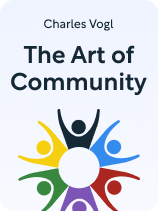

This article is an excerpt from the Shortform book guide to "The Art of Community" by Charles Vogl. Shortform has the world's best summaries and analyses of books you should be reading.
Like this article? Sign up for a free trial here.
What’s The Art of Community by Charles Vogl about? Do you belong to a community you care about and want to improve?
Community expert Charles Vogl can help you achieve your goals of building or improving a community in his 2016 book, The Art of Community. He covers everything from the beginning stages of community development to the roles and responsibilities of leaders.
Read below for a brief The Art of Community book overview.
The Art of Community by Charles Vogl
Have you ever wondered how to give back to the communities you belong to? In his 2016 The Art of Community book, Charles Vogl explains how you can participate meaningfully in your communities, make them stronger, and help them become more sustainable.
Vogl is a social justice documentary filmmaker, leadership consultant, and former member of the Peace Corps; drawing on this expertise, he offers advice for communities and their leaders in books like Storytelling for Leadership and Building Brand Communities.
In this book, Vogl describes several key practices you can incorporate—from maintaining the right meeting place to sharing community lore—to form a community, help it grow, and promote the well-being of its members. These practices apply in both online and offline communities of all types, including spiritual sects, hobby-focused communities, and for-profit organizations.
Establishing Your Community
Before you can strengthen your community, you need to establish the fundamental components that bring your community together. In this section, we’ll define what a community is and discuss the three basic building blocks of a community: healthy guidelines, a suitable meeting place, and meaningful customs.
Defining Community
According to Vogl, a community is a formal or informal collective of people who care about each other and support each other’s growth. Communities demonstrate care by fostering relationships between members, which creates a sense of belonging (the feeling that others welcome and value you). They support members’ growth by sharpening their skills and helping them refine their character.
Care and mutual support are the most basic requirements of a community, but Vogl explains that as a community develops, it develops a few other key features, too.
First, community members honor a common moral code. Vogl says people join communities because they want to be near people who care about the same things they do—for example, you might join a book group because you value literature and want to explore it with like-minded people.
A community’s ethical beliefs also tend to guide members’ behavior: Within a community that shares certain values, you’re more likely to devote time to the causes you care about, and there can be negative consequences when you fall short of community standards. For example, if you’re unfriendly to someone in your book club because they enjoy a different genre than you do, other members might question what you truly value and might even leave the community if the problem seems widespread.
Second, membership in the community comprises part of your identity. Vogl explains that when the moral code you share with your community guides your thinking and behavior, your self-perception changes: You see yourself as a particular kind of person (the kind who belongs to that particular community and honors its moral code). When your community is together, members support each other in being the kind of people you’d like to be.
Finally, as a result of the other two features, people within a community just get each other. Vogl explains that since you share a moral code, behavioral standards, and aspects of your identity, you naturally relate to and empathize with each other, and you’re at ease in each other’s company. To illustrate, LGBT people often value being part of an LGBT community because they don’t have to explain their gender and sexuality-related experiences in that community the way they do among cisgender and straight people.
Adopting Healthy Guidelines
Vogl explains that communities should adopt healthy guidelines to protect the community from negative influences and stagnation.
One guideline is that leaders should protect their communities from their own shortcomings and from the shortcomings of poorly performing members. Vogl explains that leaders can protect communities from their own shortcomings by prioritizing the success of the entire community over their personal success. This means respecting the limits of their authority, not encroaching on any member’s freedom to participate voluntarily and to enjoy other parts of life, and being accountable for their actions. To protect their communities from poorly performing members, leaders should keep abreast of and hand down consequences for inappropriate behavior.
Another guideline is that a community’s moral code should be somewhat pliable. Vogl says this doesn’t mean members should readily abandon their morals, but that they should be empowered to respectfully question and even disagree with commonly held beliefs. If consensus follows disagreement, it may reaffirm their commitment to their moral code, or they may settle on a new moral code that more accurately represents them. This may be necessary when the old moral code is now considered bigoted. If differences can’t be reconciled, some members may depart and form a new community—Vogl says that’s OK because it allows each group to honor their disparate values without perpetuating a state of intra-group conflict that disrupts bonding and cooperation.
Choosing a Suitable Meeting Place
Vogl explains that every community needs a meeting place (what Vogl calls the Temple Principle) where members can come together, enjoy each other’s company, and help each other pursue goals based on their shared moral code. A meeting place can be a traditional structure or a makeshift hangout spot. A large community may have more than one meeting place. For example, think of the global community of yoga practitioners: There are a number of traditional studios where practitioners can meet, and a small, informal group of practitioners might create a temporary meeting place by devoting one member’s living room to a yoga session. A meeting place can even be online (like a social media group for yoga practitioners).
The physical characteristics of a meeting place impact the emotional resonance of any gathering. For example, it might be more meaningful to hold a family reunion in a relative’s home that’s full of family memorabilia than in a restaurant no one has any emotional attachment to. For online communities, this doesn’t typically apply—but Vogl recommends holding offline meetings every so often to enhance members’ connections with one another.
Vogl says that if you want to make a temporary meeting place special, you should consider six factors:
1) Who will occupy the space? Vogl explains that a meeting place is made special when the right people are in attendance, so you should specifically request their presence there. For example, you might send out paper invitations for a special event at your meeting place.
2) What attire will people wear in the space? Vogl says that when people wear distinctive kinds of clothing, it marks a place and occasion as unique in some way. For example, sports fans often wear apparel representing their favorite teams when they gather for games.
3) How can meaningful elements be elevated in the space? Vogl says that to draw attention to meaningful elements (like guests of honor), you may want to physically elevate them. For example, in the US, newlyweds sometimes sit at a table upon a raised platform at their wedding receptions.
4) How does sound work in the space? Vogl explains that many communities use silence, music, or speech to create meaningful moments, so you want to ensure that the space can accommodate your sound-related needs.
5) How is the space lit? According to Vogl, if you want to draw attention to something, you should ensure that it’s well-lit, while keeping less important aspects of the environment relatively darker.
6) How is the space contained? Vogl says that to ensure a meeting place is special, it should be separated from the ordinary world by a physical marker. For example, some Wiccans use salt, candles, and other items to temporarily create a magic circle dividing their sacred space from the secular world.
Instituting Meaningful Customs
According to Vogl, communities must also institute formal and informal customs that mark meaningful moments (Vogl calls this the Rituals Principle). Common customs include celebrations of progress (like belt ceremonies in the martial arts), fun traditions (where communities engage in recreational activities together), cultural demonstrations (like ethnic food festivals), and moments of silence (especially when the community is in mourning). Customs can still happen in online communities—for example, an online craft community might hold a weekly “show off some work you’re proud of” activity.
Vogl explains that customs become meaningful when they’re repeated because repetition connects past, present, and future generations of the community. However, customs can change over time to suit newer generations’ needs—for example, family reunions might replace board games with video games. Nevertheless, customs usually follow a pattern (for instance, your community of coworkers might start each meeting by shouting out each other’s strengths and achievements before moving on to business matters).
Vogl recommends the following pattern as a basis for formal customs:
First, introduce the custom. This involves greeting participants, stating the purpose of the custom, reminding participants of previous times they practiced a custom (to help drive home meaningfulness), and giving an overview of what’s going to happen next so that each participant knows what to expect and understands any rules they have to follow.
Second, engage in the custom. Vogl recommends incorporating a few meaningful words at the start of the custom. For example, funerals often begin with a piece of scripture that provides comfort to mourners. Then, ask participants to engage in a group activity if they’re willing. Vogl notes that it’s better for the activity to have metaphorical meaning, rather than literal meaning, because this enables participants to come to their own personally meaningful conclusions about the activity’s significance.
Finally, conclude the custom by making a statement about what you’ve achieved with this custom and releasing participants from the custom or meeting place. Vogl explains that formally releasing participants helps them reorient themselves: They were doing something special, and now they’re returning to the more mundane parts of their lives.
Enhancing Your Community
Now that you understand the basic elements that bind a community together, let’s explore some key characteristics that enhance connections between community members. First, we’ll discuss the value of sharing community lore; then, we’ll explain how emblems and keepsakes foster a sense of belonging.
Sharing Community Lore
According to Vogl, sharing community lore can enhance connection between members of a community by helping them understand each other and their morals better. (Vogl calls this the Stories Principle). Typically, lore is shared via in-person conversations, but online communities can enable lore-sharing by giving members an opportunity to speak with each other virtually through text or video.
Vogl says there are three kinds of community lore:
Autobiographical lore (which Vogl calls personal stories) includes stories shared by individual members of the community about their own lives. Vogl explains that autobiographical lore is valuable because when members share their life stories, they get to know each other on a deeper level and develop more respect for each other’s tenacity in overcoming their individual struggles. Sharing autobiographical lore also builds trust and a sense of belonging within the community.
Foundational lore explains how the community came into existence and reveals the community’s moral code. Vogl says that foundational lore has three elements—it explains how members discovered something meaningful, accomplished something novel because of that discovery, and welcomed others to participate in perpetuating that process with them. Foundational lore should be accurate, but it doesn’t have to be literal—for example, religions often make use of foundational lore that’s best understood metaphorically, like creation stories.
Moral lore, according to Vogl, recounts examples of when a community came together to put their moral code into practice. For example, if a community believes in making sure all members have their financial needs met, members might share moral lore about a time when they pulled together the funds an individual needed to pay their bills. Vogl says that moral lore serves as proof that the community practices what it preaches and makes a meaningful difference in members’ lives.
Vogl also explains that it’s beneficial for communities to be vulnerable when they share lore. Based on psychologist Brené Brown’s work, Vogl defines vulnerability as a sense of emotional riskiness that occurs when someone might disapprove of what you say. He says that vulnerability strengthens community bonds because when you’re honest about your shortcomings and struggles instead of trying to maintain an image of perfection, it builds trust.
Fostering Belonging With Emblems and Mementos
Vogl explains that communities can use emblems—visuals like insignias, logos, and motifs—to foster a sense of belonging (he calls this the Symbols Principle). Emblems are metaphoric representations of a community’s moral code—for example, the US flag uses colors and symbols (stars and stripes) to symbolize the nation’s history and values (like unity and bravery). Vogl explains that emblems foster belonging because when you see them, you’re effortlessly reminded of what your community stands for and its significance to people’s lives.
According to Vogl, mementos are the most powerful form of emblems. Mementos are items bestowed upon members to keep. He explains that when one member of the community gives another member a memento, they’re signifying that the recipient is a valid and appreciated part of the community. When you’re the recipient, the memento serves as a reminder that you’re accepted and cared for. There’s no limit to what kind of item can be given as a memento as long as its meaning is clear—for example, a community of divers might give seashells to new members to mark their acceptance within the group, a group of recovering alcoholics might give members chips to mark their progress, and an online community might give out digital badges.
Vogl recommends imbuing mementos with meaning by following three steps: First, tell the recipient why they’re receiving this memento (for example, to celebrate a success). Then, tell the recipient what the memento means (for example, a seashell might represent the beauty of the ocean to a group of divers). Finally, tell the recipient the memento’s purpose (for example, reminding them that they belong).
Expanding Your Community
Once your community has been strengthened with lore, emblems, and keepsakes, it’ll be ready to invite new members in. In this section, we’ll explore Vogl’s tips for incorporating new members and discuss how to use stratification to your community’s advantage.
Incorporating New Members
Vogl explains that when communities truly believe in their moral code, they’ll want to open their group to all who could benefit from joining it. However, communities should have barriers to admittance—a line that separates those who are welcome within the community and those who aren’t, based on whether they share the same moral code. (Vogl calls this the Boundary Principle).
Vogl explains that many communities believe exclusivity is unfriendly or unfair, but he argues that barriers to admittance help community members feel safe: When the barriers are maintained, the community knows it won’t be infiltrated by people who don’t share their moral code and who would judge or even sabotage them because of their choices and beliefs. Without barriers to admittance, trust and connection eventually erode, which may cause members to become disillusioned and leave.
Using Stratification to Your Community’s Advantage
As your community grows, stratification (a division between more experienced and less experienced members) will naturally occur. Vogl (who calls this the Inner Rings Principle) explains that stratification is a good thing—it gives members something to aspire to, as it shows that there’s a potential for developing their skills and moral sensibilities and becoming better versions of themselves.
However, stratification can also present a problem when members feel compelled to continually climb to higher and higher ranks because they desire prestige. This is unhealthy because when you’re always aiming to achieve something more, you’re never satisfied with what you have now.
To remedy this pitfall, Vogl recommends that you prioritize building relationships over seeking status. Recall that the fundamental purpose of a community is to bring people together so they can support each other’s growth. If you keep that goal in mind, you’ll be more satisfied with simply being part of your community and less likely to pursue endless advancement. To help you focus on this priority, Vogl recommends participating in community activities that you enjoy often—this will enhance your connections with other members and bring you a natural sense of fulfillment.

———End of Preview———
Like what you just read? Read the rest of the world's best book summary and analysis of Charles Vogl's "The Art of Community" at Shortform.
Here's what you'll find in our full The Art of Community summary:
- The fundamental guidelines all communities should follow
- How to institute a community meeting place and set of customs
- How you can enhance belonging within your community






